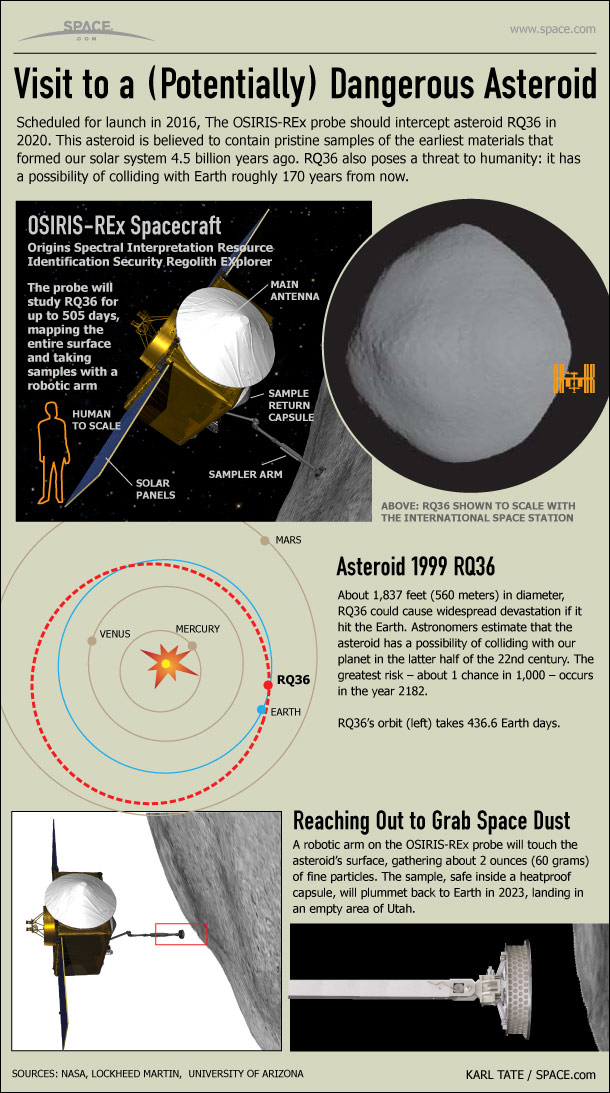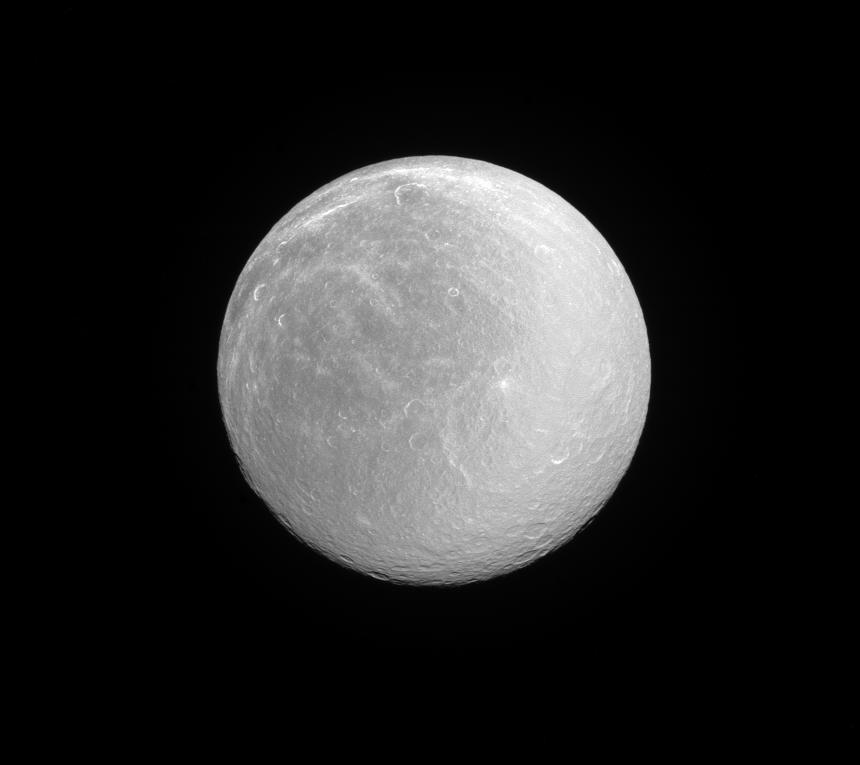| |

| Author |
Topic Options
|

 Posts:
Posts: 51947
 Posted: Posted: Tue Aug 02, 2016 8:45 am
$1: No, Asteroid Bennu Won't Destroy Earth NASA's new asteroid-sampling mission will do a lot of interesting things, but helping prepare humanity for Earth's imminent destruction is not among them. There is indeed a chance that the 1,650-foot-wide (500 meters) asteroid Bennu — the target of NASA's OSIRIS-REx spacecraft, which is scheduled to launch next month — could hit Earth late in the 22nd century. But, mission officials stressed, that chance is slim, and the space rock is not nearly big enough to pose an existential threat to the planet, despite what some media reports claimed over the weekend. [Potentially Dangerous Asteroids (Images)] "We're not talking about an asteroid that could destroy the Earth," OSIRIS-REx principal investigator Dante Lauretta, of the Lunar and Planetary Laboratory at the University of Arizona, told Space.com. "We're not anywhere near that kind of energy for an impact." Sampling an asteroid If all goes according to plan, the $800 million OSIRIS-REx (Origins, Spectral Interpretation, Resource Identification, Security, Regolith Explorer) mission will lift off atop a United Launch Alliance Atlas V rocket from Florida's Cape Canaveral Air Force Station on Sept. 8. The spacecraft will spend two years chasing Bennu down, finally rendezvousing with the near-Earth asteroid in August 2018. OSIRIS-REx will then study the space rock from orbit for another two years before grabbing at least 2.1 ounces (60 grams) of surface material in July 2020.  http://www.space.com/33616-asteroid-ben ... earth.html
|

 Posts:
Posts: 51947
 Posted: Posted: Tue Aug 02, 2016 8:48 am
$1: Saturn’s moon Rhea radiant in the sunlight In this image from NASA’s Cassini probe, Saturn’s moon Rhea appears dazzlingly bright in full sunlight. This is the signature of the water ice that forms most of the moon’s surface. Rhea (1,527 kilometres or 949 miles across) is Saturn’s second largest moon after Titan. Its ancient surface is one of the most heavily cratered of all of Saturn’s moons. Subtle albedo variations across the disc of Rhea hint at past geologic activity.  https://astronomynow.com/2016/08/01/sat ... -sunlight/
|

 Posts:
Posts: 12398
 Posted: Posted: Tue Aug 02, 2016 9:12 am
DrCaleb DrCaleb: $1: No, Asteroid Bennu Won't Destroy Earth NASA's new asteroid-sampling mission will do a lot of interesting things, but helping prepare humanity for Earth's imminent destruction is not among them. There is indeed a chance that the 1,650-foot-wide (500 meters) asteroid Bennu — the target of NASA's OSIRIS-REx spacecraft, which is scheduled to launch next month — could hit Earth late in the 22nd century. But, mission officials stressed, that chance is slim, and the space rock is not nearly big enough to pose an existential threat to the planet, despite what some media reports claimed over the weekend. [Potentially Dangerous Asteroids (Images)] "We're not talking about an asteroid that could destroy the Earth," OSIRIS-REx principal investigator Dante Lauretta, of the Lunar and Planetary Laboratory at the University of Arizona, told Space.com. "We're not anywhere near that kind of energy for an impact." Sampling an asteroid If all goes according to plan, the $800 million OSIRIS-REx (Origins, Spectral Interpretation, Resource Identification, Security, Regolith Explorer) mission will lift off atop a United Launch Alliance Atlas V rocket from Florida's Cape Canaveral Air Force Station on Sept. 8. The spacecraft will spend two years chasing Bennu down, finally rendezvousing with the near-Earth asteroid in August 2018. OSIRIS-REx will then study the space rock from orbit for another two years before grabbing at least 2.1 ounces (60 grams) of surface material in July 2020.  http://www.space.com/33616-asteroid-ben ... earth.htmlThanos won't be too happy. 
|

 Posts:
Posts: 51947
 Posted: Posted: Tue Aug 02, 2016 9:38 am
PluggyRug PluggyRug: Thanos won't be too happy.  He'll be dead 100 years by then. I'm sure he'll get over it. 
|

 Posts:
Posts: 65472
 Posted: Posted: Tue Aug 02, 2016 9:45 am
DrCaleb DrCaleb: PluggyRug PluggyRug: Thanos won't be too happy.  He'll be dead 100 years by then. I'm sure he'll get over it.  Don't be so sure of that. With the miracle that is Canada's national health programme he way well live into the 22nd century!
|
 Posted: Posted: Tue Aug 02, 2016 9:56 am
If only you were kidding, Bart.
Barring any unfortunate accidents, I intend on living for 100 years or more. I'm sure most people here who are younger than 50 will see the same if they have lived a healthy lifestyle so far.
|

 Posts:
Posts: 51947
 Posted: Posted: Fri Aug 05, 2016 8:24 am
$1: ESA, NASA’s SOHO Sees Bright Sungrazer CometESA and NASA’s Solar and Heliospheric Observatory, or SOHO, saw a bright comet plunge toward the sun on Aug. 3-4, 2016, at nearly 1.3 million miles per hour. Comets are chunks of ice and dust that orbit the sun, usually on highly elliptical orbits that carry them far beyond the orbit of Pluto at their farthest points. This comet, first spotted by SOHO on Aug. 1, is part of the Kreutz family of comets, a group of comets with related orbits that broke off of a huge comet several centuries ago. This comet didn’t fall into the sun, but rather whipped around it – or at least, it would have if it had survived its journey. Like most sungrazing comets, this comet was torn apart and vaporized by the intense forces near the sun. The disk of the sun is represented by the white circle in this image.  http://www.nasa.gov/image-feature/godda ... azer-comet
|

 Posts:
Posts: 51947
 Posted: Posted: Fri Aug 05, 2016 12:22 pm
|

 Posts:
Posts: 35256
 Posted: Posted: Fri Aug 05, 2016 2:16 pm
|

 Posts:
Posts: 51947
 Posted: Posted: Tue Aug 09, 2016 6:27 am
$1: Revolutionary Camera Recording Propulsion Data Completes Groundbreaking TestWhile thousands turned out to watch NASA’s Space Launch System (SLS) recently complete a full-scale test of its booster, few were aware of the other major test occurring simultaneously. NASA’s High Dynamic Range Stereo X (HiDyRS-X) project, a revolutionary high-speed, high dynamic range camera, filmed the test, recording propulsion video data in never before seen detail. The HiDyRS-X project originated from a problem that exists when trying to film rocket motor tests. Rocket motor plumes, in addition to being extremely loud, are also extremely bright, making them difficult to record without drastically cutting down the exposure settings on the camera. Doing so, however, darkens the rest of the image, obscuring other important components on the motor. Traditionally, video cameras record using one exposure at a time, but HiDyRS-X records multiple, slow motion video exposures at once, combining them into a high dynamic range video that perfectly exposes all areas of the video image. The HiDyRS-X project began as part of NASA Space Technology Mission Directorate’s Early Career Initiative (ECI), designed to give young engineers the opportunity to lead projects and develop hardware alongside leading innovators in industry. Howard Conyers, a structural dynamist at NASA’s Stennis Space Center, was awarded as an ECI grant in 2015. After initial proof of concept and a preliminary design review, the HiDyRS-X project was placed within NASA’s Game Changing Development program to complete its first prototype. Created in partnership with Innovative Imaging and Research Corporation, the project was tested on small rocket nozzle plumes at Stennis. The massive booster test served as a rare opportunity to test the HiDyRS-X hardware in a full-scale environment. The Qualification Motor 2, or QM-2, test was held at Orbital ATK’s test facility in Promontory, Utah, and was the second and final booster test before SLS’s first test flight in late 2018. SLS will be the most powerful rocket in the world, and will take our astronauts farther into deep space than ever before.   http://www.nasa.gov/feature/revolutiona ... aking-test
|

 Posts:
Posts: 51947
 Posted: Posted: Tue Aug 09, 2016 9:18 am
$1: Kepler finds Tabby’s Star is mysteriously dimming The so-called ‘most mysterious star in the galaxy’, also known as KIC 8462852, Tabby’s Star, the WTF (‘where’s the flux’) star and the ‘alien megastructure star’ thanks to the bizarre swarms of unknown objects transiting it, has become even stranger according to new analysis of old observations from the Kepler Space Telescope. Astronomers Ben Montet of the California Institute for Technology and Josh Simon of the Carnegie Institution looked back over the first four years of Kepler’s mission, during which it stared constantly at KIC 8462852 as well as 150,000 other stars while looking for exoplanet transits, to find that the mysterious star dimmed during that time at an unprecedented rate of 0.341 percent each year. Suffice to say, astronomers are at a loss to explain this dimming. When KIC 8462852 hit the headlines in 2015, it sparked all manner of speculation as to the origin of its bizarre behaviour (see our earlier story). Citizen scientists, using the planethunters.com website to search for transits among the stars that Kepler has been watching, began noticing strangely irregular transits of KIC 8462852. When planets transit their stars they do so in predictable fashion, with periodic transits all of the same duration and magnitude. Instead, KIC 8462852 experiences hundreds of dips in light, all with different magnitudes and with no apparent periodicity. Whatever is causing KIC 8462852’s transits, it is clearly not planets. Aside from the irregularity of the transits, there’s just far too much material. A Jupiter-sized world would block one percent of the star’s light, but during these transits up to 22 percent of KIC 8462852’s light was being blocked. The implication is that there must be a heck of a lot of material surrounding the star. Initially astronomers led by Tabetha Boyajian, previously of Yale University and now at Louisiana State University, attempted to make sense of it all by suggesting that the best explanation was a swarm of giant comet fragments resulting from a much larger body that had broken up around the star. Meanwhile, Jason Wright of Penn State University took a SETI angle, speculatively suggesting that the transits looked similar to what might be expected from orbiting ‘megastructures’, such as a partially-built Dyson swarm. A Dyson swarm, should one exist, would be composed of a multitude of solar collectors, absorbing the star’s radiated energy to provide the civilisation that constructed it with huge amounts of power. However, earlier this year Louisiana State University astronomer Bradley Schaefer revealed that KIC 8462852 had been slowly dimming for at least a century at a rate of 0.165 magnitudes per century – notably lower than the rate of dimming derived by Kepler. He came to this conclusion after studying historical photographic plates of the star that had been digitised as part of the Digital Access to a Sky Century at Harvard, or DASCH, project. If Schaefer is correct then not only would the century-long dimming rule out the comet fragments model, it would also suggest that a second mechanism is at working dimming the star, besides the shorter-term transits analysed by Boyajian’s team. Not everyone agreed with Schaefer. German astrophysicist Michael Hippke and his colleagues argued that the DASCH plates were not high enough quality to make reliable measurements from, something that Schaefer vehemently denies. However, Montet and Simon’s new research seems to lend more credence Schaefer’s results, even if it does stop short of proving Schaefer correct.  https://astronomynow.com/2016/08/08/kep ... y-dimming/
|

 Posts:
Posts: 51947
 Posted: Posted: Thu Aug 11, 2016 11:50 am
$1: Mystery object in weird orbit beyond Neptune cannot be explained
What can it be?
Far, far away it’s hard to know what it going on
ESO/L. Calçada/Nick Risinger
By Shannon Hall
“I hope everyone has buckled their seatbelts because the outer solar system just got a lot weirder.” That’s what Michele Bannister, an astronomer at Queens University, Belfast tweeted on Monday.
She was referring to the discovery of a TNO or trans-Neptunian object, something which sits beyond Neptune in the outer solar system. This one is 160,000 times fainter than Neptune, which means the icy world could be less than 200 kilometres in diameter. It’s currently above the plane of the solar system and with every passing day, it’s moving upwards – a fact that makes it an oddity.
Read more: How the sun abducted dwarf planets from an alien solar system
The TNO orbits in a plane that’s tilted 110 degrees to the plane of the solar system. What’s more, it swings around the sun backwards unlike most of the other objects in the solar system. With this in mind, the team that discovered the TNO nicknamed it “Niku” after the Chinese adjective for rebellious.
To grasp how truly rebellious it is, remember that a flat plane is the signature of a planetary system, as a star-forming gas cloud creates a flat disk of dust and gas around it. “Angular momentum forces everything to have that one spin direction all the same way,” says Bannister. “It’s the same thing with a spinning top, every particle is spinning the same direction.”
That means anything that doesn’t orbit within the plane of the solar system or spins in the opposite direction must have been knocked off course by something else. “It suggests that there’s more going on in the outer solar system than we’re fully aware of,” says Matthew Holman at the Harvard-Smithsonian Center for Astrophysics, part of the team that discovered Niku using the Panoramic Survey Telescope and Rapid Response System 1 Survey (Pan-STARRS 1) on Haleakala, Maui.
And it’s the unknown that excites astronomers. “Whenever you have some feature that you can’t explain in the outer solar system, it’s immensely exciting because it’s in some sense foreshadowing a new development,” says Konstantin Batygin at the California Institute of Technology.
https://www.newscientist.com/article/21 ... explained/
|

 Posts:
Posts: 42160
 Posted: Posted: Fri Aug 12, 2016 1:00 am
Lots of meteors tonight. 
|

 Posts:
Posts: 19986
|

 Posts:
Posts: 42160
 Posted: Posted: Fri Aug 12, 2016 10:35 am
Watched them for quite awhile. They were referring to it as a meteor storm rather than just a shower. Clouds rolled slightly before dawn.
|
 
|
Page 96 of 237
|
[ 3541 posts ] |
Who is online |
Users browsing this forum: No registered users and 2 guests |

|
|

